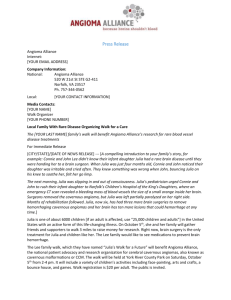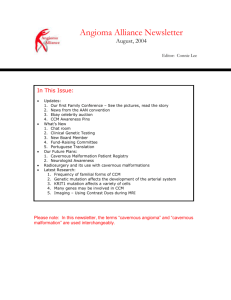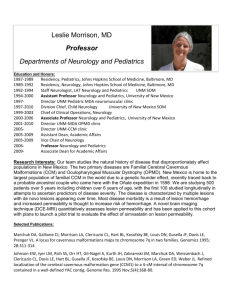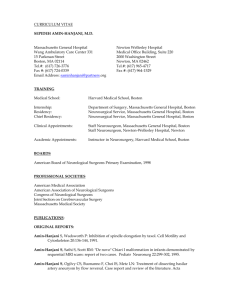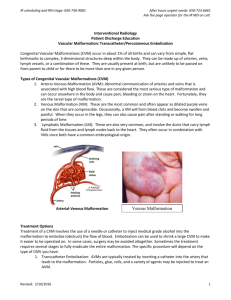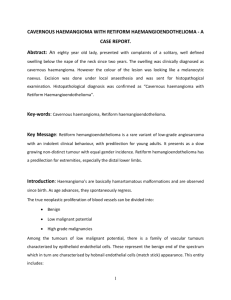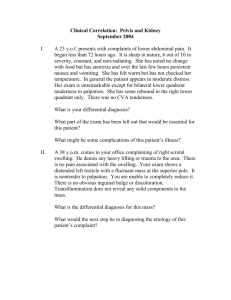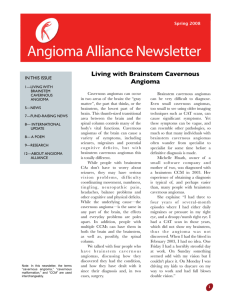Definition, Incidence Rate, Function, Diagnosis
advertisement
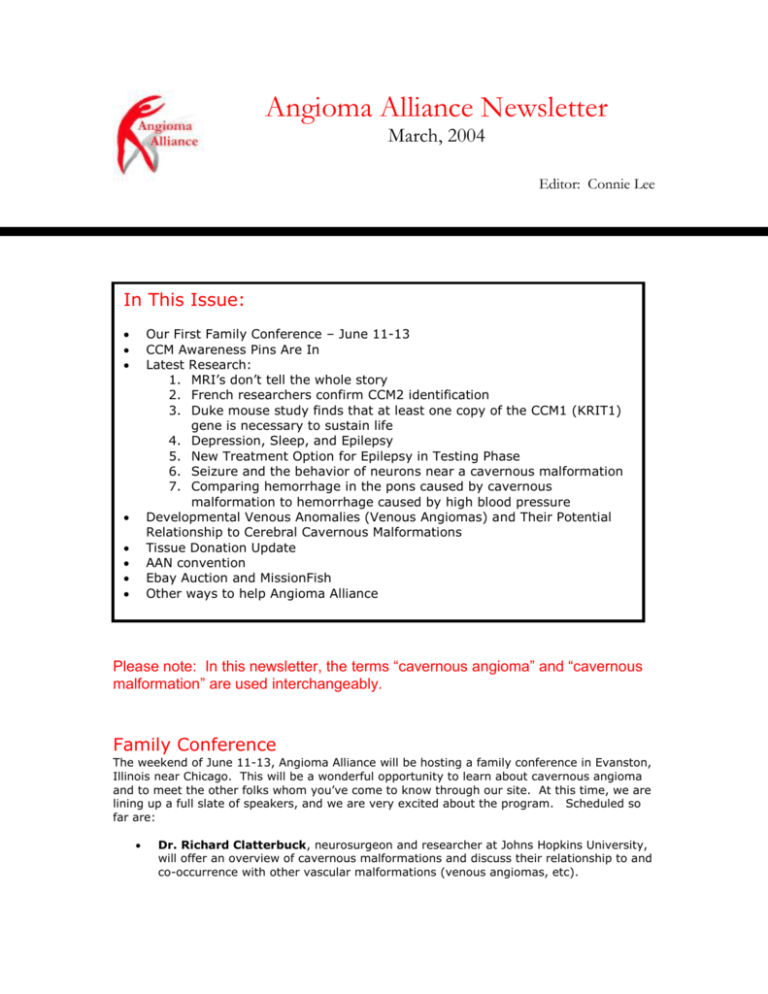
Angioma Alliance Newsletter March, 2004 Editor: Connie Lee In This Issue: Our First Family Conference – June 11-13 CCM Awareness Pins Are In Latest Research: 1. MRI’s don’t tell the whole story 2. French researchers confirm CCM2 identification 3. Duke mouse study finds that at least one copy of the CCM1 (KRIT1) gene is necessary to sustain life 4. Depression, Sleep, and Epilepsy 5. New Treatment Option for Epilepsy in Testing Phase 6. Seizure and the behavior of neurons near a cavernous malformation 7. Comparing hemorrhage in the pons caused by cavernous malformation to hemorrhage caused by high blood pressure Developmental Venous Anomalies (Venous Angiomas) and Their Potential Relationship to Cerebral Cavernous Malformations Tissue Donation Update AAN convention Ebay Auction and MissionFish Other ways to help Angioma Alliance Please note: In this newsletter, the terms “cavernous angioma” and “cavernous malformation” are used interchangeably. Family Conference The weekend of June 11-13, Angioma Alliance will be hosting a family conference in Evanston, Illinois near Chicago. This will be a wonderful opportunity to learn about cavernous angioma and to meet the other folks whom you’ve come to know through our site. At this time, we are lining up a full slate of speakers, and we are very excited about the program. Scheduled so far are: Dr. Richard Clatterbuck, neurosurgeon and researcher at Johns Hopkins University, will offer an overview of cavernous malformations and discuss their relationship to and co-occurrence with other vascular malformations (venous angiomas, etc). Dr. Issam Awad, neurosurgeon, researcher, and the chair of our Scientific Advisory Board will speak on clinical decisions for cavernous malformation. His presentation will include information about epilepsy, spinal angiomas, and radiosurgery (Gamma Knife and similar techniques). Dr. Hunt Batjer, one of the country’s top cerebrovascular neurosurgeons, will speak on advances in cavernous malformation brain and spinal surgery. Tracey Leedom, genetic counselor for the cavernous malformation research program at Duke University, will speak on the genetics of cavernous angioma and current genetics research findings. This lecture will be important not just for those who know they have the hereditary form of the illness, but also for those who believe their illness is confined to one person in their family. Dr. Eric Johnson, researcher at the Barrow Neurological Institute and director of the Genetic Alliance bio-bank, will speak on genetic testing. Dr. Murat Gunel, neurosurgeon and researcher at Yale University will speak on recent research findings and future directions for research. We will also ask a physiatrist from the Rehabilitation Institute of Chicago to present on rehabilitation and healing issues. The presentations will be followed by an extended question and answer period. We intend to offer childcare during the educational program at the conference. Lodging and some activities will be at the North Shore Doubletree Hotel in Skokie (847-6797000). The Doubletree has extended a discounted room rate of $82 per night for a nonsmoking king room or a non-smoking room with 2 double beds. We have reserved a limited number of rooms at the discounted rate – please call in your reservation early if you need lodging. Our conference registration charge will be $45 for adults and $25 for children under 16 for the entire program. There will be adjusted rates for those who will be attending only portions of the weekend. The fee for adults who will not be attending the presentation, but will be at social events is $25. The fee for children who will not be using childcare is $10. Your registration fee also includes: A wine and cheese reception on Friday evening at the hotel (donated by a friend of Angioma Alliance) A continental breakfast on Saturday at the hotel A picnic from 10 am – 2 pm on Sunday at Terminal Park near the hotel At this time, the registration fee does not include lunch and dinner on Saturday or breakfast on Sunday. The presentations will be held at the Evanston Northwestern Healthcare Hospital. We will be able to shuttle attendees back and forth between the hospital and hotel at the beginning and end of the day. We will be reserving tables at the hotel restaurant for dinner on Saturday evening. Please keep an eye on the Community Forum, or email messages on the list server or mailing list. We will be posting a registration form in the next few weeks. So far, we’ve received over 35 responses from families all over the US who are interested in attending – we would love to see you there, too. If you have any questions, please email us at info@angiomaalliance.org. The pins are in! Our CCM awareness lapel pins have arrived. Like the ribbons associated with other illnesses, our “little red guy” pin is a wonderful way to increase awareness of cerebral cavernous malformation (CCM), our little known illness. Increasing public awareness can go a long way toward increasing research funding and improving the quality of life we all lead. We’re offering the pin as a thank you for any donation of $10 or more. Each pin comes with 5 cavernous angioma information cards that can be handed to anyone who might have questions. You can send your donation through the mail to: Angioma Alliance 107 Quaker Meeting House Road Williamsburg, VA 23188 Or, if you have a Paypal account, you can use the Make a Donation button on our home page to donate using a credit card. All donations to Angioma Alliance are tax deductible. Latest Research By Connie Lee; reviewed by Issam Awad, MD Genetics MRI’s don’t always show a cavernous angioma in people who have the genetic mutation Researchers in France conducted a detailed analysis of the MRI’s and genetic mutation blood test results for members of 64 families that were identified with the KRIT1 mutation. They found some surprising and significant results. Perhaps the most important was that 5 of the 202 individuals identified with the KRIT1 mutation did not have a detectable cavernous malformation on MRI. All of these individuals were under 48 years old. This means that while they were carriers of the mutated gene and could pass this gene on to their offspring, they had not yet developed a cavernous malformation of significant size to be seen on even the most sensitive MRI. The conclusion that must be drawn from this is that MRI, while very helpful, is not a perfect way to find out if a person is carrying a genetic mutation for familial forms of the illness. A blood test is necessary to definitively rule the mutation in or out. At this time, blood tests are available for the KRIT1 and CCM2 mutations. The CCM3 mutation has not yet been identified. This study also showed that 37% of the mutation carriers, whether or not they had a cavernous malformation, were symptom-free. It must be emphasized that a less than 2.5% false negative result is extremely low, and may represent technical limitations rather than true negative MRI (i.e., gradient echo sequences or cuts performed). More sensitive MRI scans may be available in the near future and may need to be used to better screen for occult CCM lesions. Also, genetic testing (blood or cheek swabs) may themselves have false negative results as well.i French researchers confirm the identification of CCM2 gene Working independently, the primary CCM research group in France has identified the CCM2 gene. Their results confirm the Duke University group’s identification of the gene published in November, 2003 (see our November 2003 newsletter for more information about this important discovery).ii Duke mouse study finds that at least one copy of the CCM1 (KRIT1) gene is necessary to sustain life Researchers at Duke have demonstrated that mice who have lost both copies of the CCM1 gene die during embryonic development at a time roughly corresponding to the ?th month of human pregnancy. These mice exhibit vascular defects not just in the brain, but also in the heart making further development impossible. This finding lends support to the 2-hit theory of CCM1 mutation. The 2 hit theory begins with the fact that we each have two copies of any gene. When one copy mutates, the other is a backup that will perform the same function. However, the backup must work perfectly to avoid any problems caused by the original mutation. This is almost never the case for every cell in the body. The 2-hit theory explains the formation of familial cavernous malformations as the result of a mutation on the first gene that causes it to stop functioning. Intermittent but naturally occurring problems with the backup gene in some cells cause the formation of cavernous malformations. Wherever the backup gene fails, a cavernous malformation develops. As a result, if you have familial cavernous malformations you are likely to have more than one angioma.iii Epilepsy Depression, Sleep, and Epilepsy A number of studies have recently explored the relationship between daytime sleepiness, epilepsy, and depression. This research applies to those with epilepsy no matter what the cause and is not specific to those with cavernous malformations. Researchers at Drexel University and Thomas Jefferson University Medical Center have discovered that depression and sleep apnea play a greater role in excessive daytime sleepiness among those with epilepsy than do anti-seizure medications. For most people, a major symptom of depression is a sleep disturbance with resulting fatigue. People with epilepsy are prone to having untreated depression because they often do not believe their depression is abnormal, or they associate their symptoms with their medications. The obvious follow-up study, examining whether treating depression in those with epilepsy improves daytime sleepiness has not yet been done.iv In another study examining daytime sleepiness associated with epilepsy, researchers at the Marshfield Clinic in Marshfield, Wisconsin performed sleep studies on children with absence or partial seizures who were experiencing excessive daytime sleepiness. They found that the sleep patterns of these children were abnormal. They found these children wake up more during the night and take longer to reach the REM sleep (dreaming) stage. It is not yet entirely clear whether anti-seizure medications cause this change or whether the epilepsy itself causes the change, but researchers are leaning toward believing that it is the epilepsy that causes the changes that lead to excessive daytime sleepiness. Because the cause is not yet clear, researchers have not yet reached the point of exploring treatments for this sleep disturbance. v In another study on depression and epilepsy, researchers at Yale University have determined that there is a solid connection between depressive symptoms and seizure severity. Those individuals with epilepsy who were most depressed tended to have more tonic-clonic (grand mal) seizures. It is not clear whether having more seizures led to greater depression or whether depression leads to more seizures.vi New Treatment Option for Epilepsy in Testing Phase A private corporation, NeuroPace, has developed a device that when implanted in the brain detects the electrical onset of a seizure and responds with an electric shock to stop it. The device is used primarily for seizure disorders that cannot be corrected with surgery because the seizures originate from areas of the brain that perform needed functions. The FDA has approved an 11-center trial that is scheduled to begin this year. It is too early to judge whether there would be any role for this treatment in lesional epilepsy associated with CCM, where lesion resection is a highly effective treatment for intractable seizures.vii Physiology of neurons adjacent to CCM A Yale study compared the activity of neurons next to cavernous malformations to the activity of neurons next to glial tumors to determine whether they induce seizures in the same way. Glial tumors are cancerous tumors of the supporting tissue of neurons. Both cavernous malformations and glial tumors are associated high rates of seizure. However, the affect each has on surrounding neurons, where seizure originates, differs. Both when stimulated and when exhibiting spontaneous activity, neurons next to cavernous malformations showed more excitable responses than those next to glial tumors. This indicates that cavernous malformations induce seizures in a way that is different from tumors.viii Brainstem Cavernous Malformations Hemorrhage in the pons: comparison of outcome depending on cause Researchers in Minnesota examined the records of 44 patients who suffered a hemorrhage in the pons as a result of either a cavernous malformation or as a result of high blood pressure (hypertension) alone. They found that those who had suffered hemorrhage as a result of cavernous malformation generally had better outcomes. Only 5% of those with a cavernous malformation hemorrhage were left with a severe disability as compared to 62% of those with hemorrhage resulting from hypertension. Hemorrhage in the pons associated with CCM has a better outcome than brainstem hemorrhage in older patients with hypertension. ix Developmental Venous Anomalies (Venous Angiomas) and Their Potential Relationship to Cerebral Cavernous Malformations By Jack Hoch; reviewed by Issam Awad, MD While great strides have been made in the understanding and treatment of cerebral cavernous malformations (CCM), the creation mechanism behind these lesions remains poorly understood. In the same vein (pun intended), another lesion called a venous angioma (a.k.a. developmental venous anomaly or DVA) has received increased scrutiny in recent years. Even though the neurosurgical community has categorized DVAs as benign lesions, there are burgeoning concerns that DVAs may be involved in the genesis or growth of cerebral cavernous malformations and other brain lesions such as arteriovenous malformations (AVM). Definition, Incidence Rate, Function, Diagnosis, and Treatment A DVA is a radial arrangement of veins usually draining into one slightly enlarged, main or central vein. Sometimes you will hear the descriptive term “caput medusae” (Latin for “head of Medusa”) used to describe this feature, since the vein pattern resembles the snakes of hair from the Medusa character of Greek mythology. DVAs have the highest prevalence rate (over 60%) of all intracranial vascular malformations.x They may appear anywhere in the body. Like CCMs, multiple DVAs may exist within the same individual. It is thought that one person in fifty has at least one DVA. The brain’s venous network acts as a conduit to drain blood from the brain so that this blood can be re-oxygenated by the lungs. Even though DVAs are anomalous structures, they are fully integrated with the body’s venous system and provide the brain with normal blood drainage function. Diagnosis is either via an incidental finding during imaging of other lesions, or during autopsy. Conventional computed tomograms (CTs) may not always document DVAs sufficiently, although newer high resolution CT scans with thin cuts and contract enhancement, and CT angiogram (CTA) reconstructions can image these lesions, as well as MRI/MRA and conventional angiograms. With these non-invasive modalities, the vast majority of suspected DVAs should not be subjected to the risk of catheter angiography, except in rare instances where a true AVM may be suspected clinically. The generally passive nature of DVAs requires an expectant course of management. Because these anomalies provide a useful and important blood draining function, in no case should they be excised or radiated. Doing so during surgery, either by accident or intent, has resulted in venous infarction and patient death. This includes those instances of CCM resection in association with a DVA. While the CCM can be safely removed, the DVA must remain undisturbed. Both clinical and radiographic information must be integrated when considering diagnosis and treatment of mixed vascular malformation such as DVA-CCM.xi DVA Implications for Other Lesions Neurosurgeons classify DVAs as benign lesions because they normally do not present with any clinical symptoms during one’s lifespan. However, there are a few case studies that point to potential DVA-associated hemorrhage due to blockage or narrowing of the structure’s drainage channel, causing a transient rise in pressure within the draining veinsxii. Whether or not the hemorrhage originated from the DVA or from an associated, poorly visualized (or posthemorrhage obliterated) CCM or AVM remains controversial. The most sinister aspect of DVAs is their potential role in the creation of other types of vascular malformations that cause clinical symptoms. The literature has documented DVA association in conjunction with other malformations such as CCMs or AVMs.xiii With the recent advent of higher resolution imaging techniques, this association has become a more common finding.xiv Solitary non-familial CCMs are much more likely to be associated with DVA than multifocal familial CCMs, but few other differences in clinical profile are evident.xv Once again, the importance of using gradient-echo MRI sequences as a diagnostic tool to identify punctate CCMs next to DVAs cannot be overemphasized. A similar line of reasoning to the above DVA bleed theory has been postulated for the formation of CCMs in association with DVAs. Basically, obstruction or narrowing of the draining vein alters blood flow and venous pressure, somehow inducing an adjacent CCM. Since CCMs communicate freely with the venous system, anything that negatively affects venous system pressure or drainage can have dire consequences for the CCM itself.xvi Again, this is a generally accepted theory that has not been definitively proven. This CCM inducement theory reinforced the medical community’s recent discounting of the congenital nature of CCM formation. Instead it is now widely acknowledged that CCMs can develop in a “de novo” fashion. Pre and post radiation treatment MRI sequences confirm that CCM’s do indeed develop where previously no CCM had been present. The exact mechanism leading to CCM formation has not been found, so until proven otherwise, the DVA-CCM link will continue to garner great interest. Tissue Donation Update Angioma Alliance has become more actively involved in facilitating cavernous angioma tissue donation to research laboratories. We now have published descriptions of research projects at the University of Colorado, Northwestern University, and Duke University on our Ongoing Research page. We are also aware that Johns Hopkins and Yale University are in need of cavernous malformation tissue and are working to obtain their study descriptions. We would like to encourage anyone facing surgery in the US who would like to donate their cavernous angioma to call us at our new toll-free number 1-866-HEAL-CCM so that we can help to make arrangements. You may also call the labs directly. The process is relatively simple from the donor’s end. Labs desperately need cavernous angioma tissue. Your donation could make a big difference in the pace of research progress. AAN Convention Angioma Alliance will be exhibiting at the American Association of Neurologists annual convention in San Francisco in April. We hope to bring the resources of our organization to the attention of neurologists and to encourage them to think about cavernous malformations as they approach diagnosis. Connie Lee and Norma Villa of the Angioma Alliance board and Liz Neuman, parent of two children with cavernous malformations, will be staffing our booth. We would like to get together with anyone in the Bay area for dinner on either Tuesday or Wednesday evening April 27 or April 28 near the Moscone Convention Center. We would love to meet others from this area. If you would like to get together, please email us at info@angiomaalliance.org. Ebay Auction and MissionFish On May 9, Angioma Alliance will begin its second annual Ebay Charity Auction. We have been soliciting autographed donations from celebrities and are starting to receive donated items. Perhaps you have an item that you would like to donate to the auction. It doesn’t need to be a celebrity autographed item, just something that you believe will sell. If you do, please contact us at info@angiomaalliance.org to discuss arrangements for the sale. An alternate way to use Ebay to help Angioma Alliance is to register as a seller with MissionFish. This allows you to designate a percentage of the sales price of items you sell as a donation to Angioma Alliance. You keep the remaining percentage. Other Ways to Help Angioma Alliance Did you know that there are ways to help Angioma Alliance while you shop online? If you use the button located on the Bookstore page of our site to visit Barnes and Noble online, 5% of any purchase you make will be donated to us. Recent book recommendation: Growing Up With Epilepsy: A Practical Guide for Parents by Lynn Bennett Blackburn. A second way to help Angioma Alliance while you shop is to do your shopping through the igive.com website and designate Angioma Alliance as your charity. Igive.com provides a simple way for you to earn money for Angioma Alliance without cost to you. Simply go to www.igive.com and register. Each time you shop, go through the Igive.com site to get to your retailer, and a percentage of your purchase price will be given to us. There are hundreds of stores, including most major retailers, which participate in this program. You do not pay any more for your items, and this helps us to continue providing a website, producing educational materials, and increasing awareness of cavernous angioma. Denier C, Labauge P, Brunereau L, Cave-Riant F, Marchelli F, Arnoult M, Cecillon M, Maciazek J, Joutel A, Tournier-Lasserve E; Societe Francaise de Neurochirgurgie; Societe de Neurochirurgie de Langue Francaise. Clinical features of cerebral cavernous malformations patients with KRIT1 mutations. Ann Neurol. 2004 Feb;55(2):213-20. i Denier C, Goutagny S, Labauge P, Krivosic V, Arnoult M, Cousin A, Benabid AL, Comoy J, Frerebeau P, Gilbert B, Houtteville JP, Jan M, Lapierre F, Loiseau H, Menei P, Mercier P, Moreau JJ, Nivelon-Chevallier A, Parker F, Redondo AM, Scarabin JM, Tremoulet M, Zerah M, Maciazek J, Tournier-Lasserve E; Societe Francaise de Neurochirurgie. Mutations within the MGC4607 gene cause cerebral cavernous malformations. Am J Hum Genet. 2004 Feb;74(2):326-37. ii Whitehead KJ, Plummer NW, Adams JA, Marchuk DA, Li DY. Ccm1 is required for arterial morphogenesis: implications for the etiology of human cavernous malformations. Development. 2004 Mar;131(6):1437-48. iii Saladoff MacNeill J. Sleepiness in epilepsy linked to depression, sleep apnea. CNS News 6(3): 74, March 2004. iv Wilner AN. Abnormal sleep decreases attention in children with primary generalized epilepsy . CNS News 6(3): 74, March 2004. v vi Wilner, AN. Depression correlates with seizure severity. CNS News 6(3): 75, March 2004. vii Wilner AN. Implant detects, then aborts, seizures. CNS News 6(3): 76, 80, March 2004. Williamson A, Patrylo PR, Lee S, Spencer DD. Physiology of human cortical neurons adjacent to cavernous malformations and tumors. Epilepsia. 2003 Nov;44(11):1413-9. viii Rabinstein AA, Tisch SH, McClelland RL, Wijdicks EF. Cause is the main predictor of outcome in patients with pontine hemorrhage. Cerebrovasc Dis. 2004;17(1):66-71. x Ciricillo SF, Dillon WP, Fink ME, et al. Progression of multiple cryptic vascular malformations associated with anomalous venous drainage. Case report. J Neurosurg 81:477--481, 1994. ix Robinson JR Jr, Awad IA, Masaryk TJ, et al. Pathological heterogeneity of angiographically occult vascular malformations of the brain. Neurosurgery 33:547–555, 1993. xi Field LR, Russell E. Spontaneous hemorrhage from a cerebral venous malformation related to thrombosis of the central draining vein: demonstration with angiography and serial MR. AJNR AmJ Neuroradiol 1995;16:1885–1888. xii Abe T, Singer RJ, Marks MP, Norbash AM, Crowley RS, Steinberg GK. Coexistence of occult vascular malformations and developmental venous anomalies in the central nervous system: MR evaluation. American Journal of Neuroradiology 19:51-57, 1998. xiii Maeder P, Gudinchet F, Meuli R, de Tribolet N. Development of a cavernous malformation of the brain. Am J Neuroradiol 19, 1141-1145, 1998. xiv Abdulrauf SI, Keynar M and Awad IA. A comparison of the clinical profile of cavernous malformations with and without associated venous malformations. Neurosurgery 44: 41-47, 1999. xv Little JR, Awad IA, Jones SC, Ebrahim ZY. Vascular pressures and cortical blood flow in cavernous angioma of the brain. Journal of Neurosurgery. 73(4): 555-9, Oct 1990. xvi
